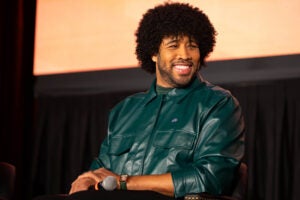April 3, 2025 | ISOJ2025
Second Trump administration weaponizes chaos and overwhelms media, say journalists at ISOJ
Haga clic aquí para leer este artículo en español.
Covering Donald Trump has long been a difficult task for journalists in Washington, but his new administration has such a frenetic pace that the challenge has become even more complex. In the panel “Covering Trump 2.0: Challenges facing journalists in Washington, DC”, held Friday, March 28, at the 26th International Symposium on Online Journalism (ISOJ), experienced political journalists shared insights, assessed dangers to democracy and independent journalism, and discussed how the press can rise to the historic moment.
The panel, hosted in the Shirley Bird Perry Ballroom at the University of Texas in Austin, brought together Elizabeth Kennedy, White House editor of the New York Times; Ashley Parker, staff writer for The Atlantic; Eugene Daniels, president of the White House Correspondents’ Association and Washington correspondent for MSNBC; and moderator Evan Smith, co-founder of The Texas Tribune.
A key point raised was the Trump administration’s deliberate strategy of “flooding the zone,” overloading the press and other power structures with multiple simultaneous events. Parker, from The Atlantic, described how this tactic was implemented on the first day of government, with the signing of more than 20 executive orders and three speeches.
“Their attitude was like, screw you. You have to choose. You can either go all in on pardoning the January 6-ers, you can go all in on the immigration executive orders, you can cover him at the balls, you can cover his speeches. But you can’t do all of it,” Parker said. “I feel like we’ve all been scrambling to figure out what to cover, and how to cover.”
Kennedy, from the New York Times, reinforced the need for journalists to recognize and adapt to this strategy. While it is necessary to cover daily events, journalists also need to focus on big stories and structural transformations, she said.
“There’s a million stories, and we have to cover that, but we also need to step back and keep our eyes on the big stories, the big changes. How Trump sees power, how he’s changing the American presidency,” she said. “These are big meaty issues, and I think the danger is being pulled down every day into the minutiae.”
Another element that draws attention is the government’s willingness to challenge democratic norms and conventions, Parker said.
“A lot of a democratic society functions on norms and niceties and social constructs,” she said. “And the thing he understands now is that a lot of that, it turns out, you can run roughshod over.”
Building an alternative reality
Among the examples mentioned is Trump’s attempt to directly interfere with news coverage. Daniels, president of the White House Correspondents’ Association, recalled that, in his first term, Trump tried to ban journalists, but was restrained by advisers. Now, that has changed. Daniels explained that the White House is trying to take away from the Correspondents’ Association the power to decide who participates in the press pool, a break with a decades-old tradition.

“Presidents for a very long time, decades, have allowed that relationship to be what it is because they knew that they are stronger if the people who are asking them questions are people who are well informed, people who are best sourced,” Daniels said. “The people that are being covered should not choose the people that are covering them. Period.”
Panelists highlighted how Trump has learned since his first term that he can “bend reality to his will” and that much of democratic society operates based on norms – not rules – that can be ignored. Ashley Parker noted this as a learning experience on the president’s part.
“He has learned the lessons of the 2020 election, which he lost, and the lessons of January 6th, which was a deadly insurrection and attack on the U.S. capital”, she said. “It is that, if he repeats something enough, he can get enough of the American public to believe it.”
Kennedy pointed out how this strategy manifested itself in the recent episode involving the leak of military plans by The Atlantic magazine.
“If I say this information is not classified and no big deal, then it is not classified and it is no big deal. Period, end of story”, she said. “They all just decide, ‘what we say is the reality.’ ”
The homogeneity among members of the current administration constitutes an important difference between Trump’s first and second terms, the members of the panel agreed.
“There are no apostates in this administration. The closing of ranks is easy, everybody is falling in line,” said moderator Evan Smith. “There were people in the last administration who might have actually said on the side, ‘This is bad, this is terrible.’ No one is breaking ranks this time.”
Threatened credibility
The panelists also addressed how Trump’s strategy of distorting reality affects the credibility of journalism as a whole. Daniels warned that the president not only convinces his supporters of lies, but also makes other people skeptical of politics.

“When we come to folks with real information, verifiable information that we know to be true, people won’t believe it, because the well of truth is poisoned,” he said.
Faced with this challenge, one of Parker’s suggestions was to produce contextual articles, bringing together scattered information and showing how they are linked together. These publications tend to have great repercussions, because readers are “hungry” for content that organizes the informational chaos.
“Something that pulls it all together and explains the details and the scoops, why it matters and in what direction this could go in,” she said.
During the Q&A with the audience, panelists discussed how the influencer ecosystem influences political practices. Daniels noted that while social media platforms may appear to have limited influence among the general public, their impact is amplified.
“The people that actually are paying attention to it are the people who are making the laws,” he said. “Does my grandmother see it? Absolutely not. Does someone’s cousin in Iowa see it? Probably not. But the impact on their life will be felt, because the people that are making the decisions in Washington, D.C. and around the country and leadership positions are paying attention.”
The panel also addressed the challenges faced by local outlets, especially following changes in the relationship between the White House and the Associated Press, which tends to represent many smaller outlets. Kennedy highlighted the importance of local coverage of the impacts of federal decisions.
“You will be the front line of whatever the effects of these decisions in Washington will be,” she said. “Who are the people being affected by this? Who’s being hurt, who’s being helped?”
Trump 2.0 instrumentaliza el caos y satura a los medios, según periodistas en 26° ISOJ
Cubrir a Donald Trump ha sido durante mucho tiempo una tarea difícil para los periodistas en Washington, pero su nueva administración tiene un impulso tan frenético que el desafío se ha vuelto aún más complejo. En el panel “Cubriendo a Trump 2.0: Desafíos a los que se enfrentan los periodistas en Washington DC”, celebrado el viernes en el Simposio Internacional de Periodismo Online (ISOJ), experimentados periodistas de política compartieron puntos de vista, evaluaron los peligros para la democracia y el periodismo independiente y debatieron sobre cómo la prensa puede estar a la altura de este momento histórico.
El panel, celebrado en el Shirley Bird Perry Ballroom de la Universidad de Texas en Austin, reunió a Elizabeth Kennedy, editora de la sección White House de The New York Times; Ashley Parker, periodista de The Atlantic; Eugene Daniels, presidente de la White House Correspondents’ Association y corresponsal en Washington de MSNBC; y Evan Smith, cofundador de The Texas Tribune y asesor del Colectivo Emerson, quien fungió como moderador.
Uno de los principales puntos planteados fue la estrategia deliberada de la administración Trump de “inundar la zona”, es decir, sobrecargar a la prensa y a otros órganos de poder con múltiples eventos simultáneos. Parker, de The Atlantic, describió cómo se implementó esta táctica en su primer día en el cargo, con la firma de más de 20 órdenes ejecutivas en pocas horas, muchas de ellas ambiciosas, y tres discursos diferentes.
“Su actitud fue como, ‘es tu problema, tienes que elegir’. Ya sea que dedicarámos nuestros esfuerzos al indulto de los invasores del 6 de enero o a las órdenes ejecutivas de inmigración, o a cubrir los bailes, o sus discursos. Pero no podíamos hacerlo todo”, dijo Parker. “Siento que todos estamos luchando por saber qué cubrir y cómo cubrirlo”.
Kennedy, de The New York Times, reforzó la necesidad de que los periodistas reconozcan y se adapten a esta estrategia. Aunque es necesario cubrir los acontecimientos diarios, los periodistas también deben centrarse en las grandes historias y en las transformaciones estructurales, dijo.
“Hay un millón de historias, y tenemos que cubrir eso, pero también tenemos que dar un paso atrás y mantener la mirada en las grandes historias, los grandes cambios. Cómo ve Trump el poder, cómo está cambiando la presidencia estadounidense”, dijo la periodista. “Son cuestiones importantes y creo que el peligro es reducirse a minucias cada día”.
Otro elemento llamativo es la voluntad del Gobierno de desafiar las normas y convenciones democráticas, dijo Parker.
“Gran parte de una sociedad democrática funciona sobre la base de normas y sutilezas y construcciones sociales”, dijo. “Y lo que él entiende ahora es que mucho de eso, al parecer, se puede ignorar”.
Construyendo una realidad alternativa
Entre los ejemplos mencionados está el intento de Trump de controlar directamente la cobertura informativa. Daniels, presidente de la White House Correspondents’ Association, recordó que en su primer mandato, Trump intentó prohibir la entrada a los periodistas a la Casa Blanca, pero fue frenado por sus asesores. Ahora eso ha cambiado. Daniels explicó que la Casa Blanca está tratando de quitar a la White House Correspondents’ Association el poder de decidir quién participa en las conferencias de prensa, una ruptura con décadas de práctica.
“Durante mucho tiempo, décadas, los presidentes permitieron que esa relación fuera la que es porque sabían que serían más fuertes si las personas que les hacían preguntas eran personas bien informadas, personas con mejores recursos”, dijo Daniels. “Las personas a las que se cubre no deberían elegir a las personas que les cubren. Y punto”.
Los panelistas destacaron cómo Trump ha aprendido desde su primer mandato que puede “doblegar la realidad a su antojo” y que gran parte de la sociedad democrática funciona sobre la base de normas -no leyes- que pueden ser ignoradas. Ashley Parker observó esto como una experiencia de aprendizaje por parte del presidente.
“[Trump] aprendió las lecciones de las elecciones de 2020, que perdió, y las lecciones del 6 de enero, que fue una insurrección mortal y un ataque a la capital estadounidense”, dijo. “Es decir, que si repite algo lo suficiente, puede conseguir que gran parte de la opinión pública estadounidense se lo crea”.
Kennedy señaló cómo se manifestó esta estrategia en el reciente episodio de la filtración de planes militares por parte de la revista The Atlantic.
“Si digo que esta información no es clasificada y no es gran cosa, entonces no es clasificada y no es gran cosa. Y punto, fin de la historia”, dijo. “Todos deciden que lo que decimos es la realidad y esa es la historia que vamos a seguir”.
La uniformidad entre los miembros del actual Gobierno constituye una diferencia crucial entre el primer y el segundo mandato de Trump, coincidieron todos los panelistas.
“No hay apóstatas en este Gobierno. Cerrar filas es fácil, todo el mundo está en línea”, dijo el moderador Evan Smith. “Había gente en el anterior Gobierno que podría haber dicho desde la barrera: ‘sabes, esto es malo, esto es terrible’. Rompían filas. Esta vez nadie rompe filas”.
Credibilidad amenazada
Los panelistas también abordaron cómo la estrategia de Trump de distorsionar la realidad afecta a la credibilidad del periodismo en su conjunto. Daniels advirtió que el presidente no solo convence a sus partidarios de mentiras, sino que también hace que otras personas se muestren escépticas ante la política.
“Cuando llegamos a la gente con información real, verificable, que sabemos que es cierta, la gente no la cree, porque el pozo de la verdad está envenenado”, dijo.
Ante este reto, una de las sugerencias de Parker fue producir historias contextuales, reuniendo piezas de información dispersas y mostrando cómo encajan entre sí. Estas publicaciones suelen tener gran repercusión, porque los lectores están “hambrientos” de contenidos que organicen el caos informativo.
“Algo que lo reúna todo y explique los detalles y la información, por qué es importante y qué dirección puede tomar”, explicó Parker.
En la sección de preguntas y respuestas con la audiencia, se prestó mucha atención a cómo el ecosistema de influencers impacta en las prácticas políticas, con el ejemplo del nombramiento de Pete Hegseth y la presión coordinada de los partidarios de Trump sobre la senadora Joni Ernst. Daniels señaló que, aunque pueda parecer que las plataformas de redes sociales tienen una influencia limitada entre el público en general, su impacto se amplifica.
“Las personas que realmente están prestando atención a esto son las personas que hacen las leyes”, dijo. “¿Lo ve mi abuela? Por supuesto que no. ¿Lo ve el primo de alguien en Iowa? Probablemente no. Pero el impacto en sus vidas se sentirá, porque las personas que toman las decisiones en Washington y en todo el país y los puestos de liderazgo sí están prestando atención”.
El panel también abordó el desfío al que se enfrentan los medios locales, especialmente tras los cambios en la relación entre la Casa Blanca y la agencia Associated Press, la cual suele representar a muchos medios más pequeños. Kennedy subrayó la importancia de la cobertura local de las repercusiones de las decisiones federales.
“Estarán en la primera línea de lo que ocurra en Washington”, dijo. “¿Quiénes son las personas afectadas? ¿A quién perjudica, a quién ayuda?”

